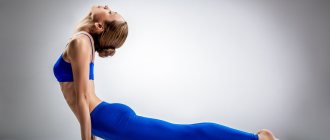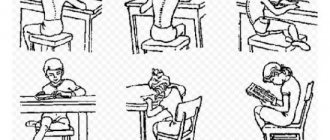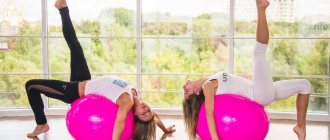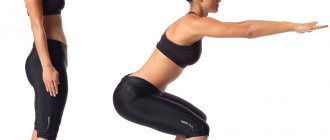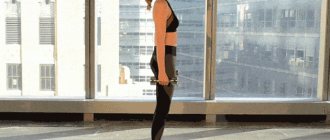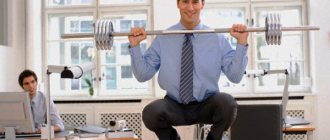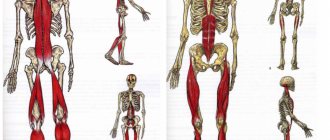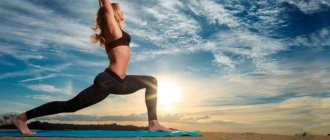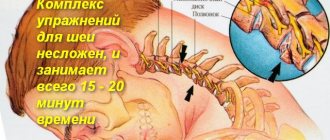What is the "daily dozen"
This is a simple workout that should be easy and fun. It develops flexibility, improves posture, muscle coordination and balance.
Camp argued that exercise has a positive effect on the functioning of internal organs, in particular the intestines, and also improves cognitive functions, improving brain function.
The Daily Dozen is suitable for any adult, but is especially useful for middle-aged people who experience some tightness in their bodies and sit most of the day.
A set of exercises for the development of physical qualities
A set of exercises for the development of physical qualities.
Basova Olga Nikolaevna,
physical education teacher
Municipal budgetary educational institution
Surgut Natural Science Lyceum
Sets of exercises for the development of physical qualities in students
Complex 1
1. I.p. - stand at a distance of 0.5 m from the wall (facing it). Bending and extending your arms, resting your fingers on the wall.
2.I.p. - stand with legs apart, hands with dumbbells (up to 1 kg) to the shoulders. Lower your arms down, raise them to the sides, up, return them to i. P.
Options: IP - sitting, lying on your back.
3 Hanging on the bar: on two hands, on one hand (left, right), on bent arms.
4.I.p. - lying position (on knees, on hips). Flexion and extension of the arms.
Options: feet on a chair, face up.
5.I.p. - support on the backs of a chair or parallel bars, legs in support in front (behind). Bending and straightening of arms.
Options: legs in a tucked position, in an angle position.
6. . Pull-ups on the bar while hanging while lying down.
7 Climbing on a rope, on a horizontal ladder.
8. In pairs. Standing one behind the other, hold hands. The first one raises and lowers his arms to the sides, overcoming the resistance of the second. Partners change places after 4-6 attempts.
9. In pairs. One partner takes a lying position (face down), the second lifts his legs. Walking on your hands.
Option: lying face up.
Complex 2
I.p. – legs wide apart. Squats on the left and right leg. Option: the same with weights.
I.p. - sitting position, hands behind. Raising and lowering straight legs.
Running in place with vigorous movements of the arms and legs.
Starts from various positions (from a crouching position, lying down, from sitting and standing positions with your back to the running side) and jogging up to 10 m. After each start, rest for 30 seconds. After 8 starts, rest for 2-3 minutes.
In pairs. I. p. - standing with your back to each other, hands connected at the back at the elbow joints. Squats and half-squats, squat jumps forward, backward, to the sides.
In pairs. Pulling the partner by the hands, by the belt (legs bent, apart).
In pairs. IP - emphasis while sitting facing each other, legs bent.
Simultaneous and alternate resistance of partners with their feet.
Multi-jumps from foot to foot, on two, on one (left and right). After performing 10-12 multi-jumps, rest for 2 minutes.
Complex
1. I.p. - lying on your back, arms up: jerking your legs and torso up into a sitting angle (“jackknife”). In the final position, touch your toes with your fingers. Breathing: lying on your back - inhale, sitting at an angle - exhale. , 2. I.p. - as in the previous exercise: jerking the legs and torso up into a squat position with alternating turns of the torso to the right and left. Breathing as in the previous exercise. 3. I.p. — lying on the floor, legs bent at the knees and secured on a stand, hands behind the head: raise your head and touch your chest with your chin, then lift your shoulder girdle (tear your shoulder blades off the floor) and hold for 3-5 seconds, return to the position. Breathing: i.p. - inhale, head forward and muscle tension - exhale. 4. I.p. - lying with your back on an inclined board, head down, legs secured and slightly bent at the knees, hands behind your head: lifting your torso up and forward, using your fingers to reach your toes. Breathing - as in previous exercises. 5. I.p. - lying on your back on the floor, legs secured on a stand, hands behind your head in a lock: raising your torso and bending forward until your chest touches your knees. To complicate the exercise, it can be performed with weights on the shoulders (bar or barbell disc, kettlebell). Breathing: lying in i.p. - inhale, lift the body - exhale. 6. I.p. - sitting on your hips and buttocks on the edge of the bench, legs secured, hands clasped behind your head, lower your torso below the level of the bench, bend your back: lifting your torso and bending forward until your chest touches your knees. To make the exercise more challenging, perform it with weights on your chest or behind your head. Breathing - as with the previous exercises. 7. I.p. — lying with your back on an inclined board, head down, legs secured and half-bent at the knees, hands behind your head in a lock: lifting the body up with alternating turns left and right until the elbow touches the opposite knee. The exercise can be performed with weights on the shoulders. Monitor your breathing rhythm. 8. I.p. - lying with your back and buttocks on the edge of a horizontal bench, grab its edges with your hands: raising straight legs, trying to lower your toes behind your head. Breathing: i.p. - inhale, lift your legs - exhale. 9. I.p. — lying with your back on a horizontal bench, grab its edges with your hands: bending straight legs at the hip joints, overcoming the resistance of a rubber shock absorber (tourniquet, bandage, etc.). Breathing: i.p. - inhale, bend your legs - exhale. 10. I.p. - hanging on the bar: raising your knees to your chest. Breathing: i.p. - inhale, knees to chest - exhale. 11. I.p. - sitting on an inclined board with half-bent legs fixed at the top: turns the body left and right until the elbow touches the knee of the opposite leg. Monitor your breathing rhythm. 12. I.p. - sitting at an angle on a bench
Daily Dozen Exercises
Exercise 1. Arm circles
Develops the muscles of the shoulders, back and chest, improves posture.
- Stand up straight, raise your arms straight to the sides at shoulder level, palms facing up.
- Slowly draw small circles with your hands about 15 centimeters in diameter. Most of the movement comes from the shoulders, tension is felt in the back of them.
- Perform five circles forward and five back.
Exercise 2. Bend over with hands behind head
Stretches the abdominal muscles, strengthens the back, improves posture.
- Stand up straight, put your hands behind your head.
- As you exhale, tilt your body forward to 45 degrees, your neck in line with your back, and look at the floor in front of you.
- With an inhalation, straighten up and raise your head.
- Bend back slightly to feel the stretch in your abdominal muscles. The gaze is directed to the ceiling.
- Stand up straight. The head remains raised.
- Repeat 10 times.
Exercises to develop coordination
Below we will describe exercises that can be performed without the use of specialized exercise equipment. Daily simple exercises will not take much time, but will help you achieve good results. In addition, these exercises have a beneficial effect on many organs.
If you are too lazy to read or it’s easier for you to perceive visually, then here is a useful video that contains basic exercises for the targeted development of coordination.
Pole with ropes
This exercise helps to relax the arms, shoulders and relieve tension in the neck.
You need to stand up straight and place your feet at shoulder level. You can imagine the torso as a pillar, and the arms as ropes that are tied to it. When performing the exercise, your hands should be completely relaxed. You need to turn around an axis and fully transfer your body weight, gradually increasing speed.
Heron
When performing this exercise, you need to lean on one leg. It has been practiced for centuries in Eastern medicine and has a positive effect on the immune system, since the channels of six important internal organs are located on the feet. In addition, it prevents the development of varicose veins. It must be performed without shoes.
You need to lean on one leg, and raise the other so that the thigh is parallel to the floor (if possible, higher). If it is not possible to raise your leg high, stop at the maximum possible height.
Extend your arm with the same name as your raised leg in front of you, without fully extending it. Keep your other hand in a lowered position. Once you have reached the desired position, try to maintain your balance with your eyes closed.
Video clip
This exercise has a positive effect not only on the coordination system, but also on the entire body. It helps strengthen the spinal muscles and improves blood circulation. This exercise requires a flat surface. Initially, the exercise may cause discomfort, in which case you can use a mat.
In a sitting position, pull your legs towards your body, clasping them with your arms. It is necessary to round your back as much as possible. With a quick movement you need to lean back, roll over onto your back and return to your original position.
Hammer
The hammer exercise also has a beneficial effect on the spine, more precisely on its upper part. It is quite simple, but it is important to know when to stop. When performing this, crunching sounds may be heard, but there is no need to worry about this.
You need to lie down and clasp your shoulders with your hands, then slightly raise your upper body and begin to lightly “tap” your back on the floor.
Sphinx and Cobra
This exercise allows you to develop a good reaction and has a positive effect on the spine.
It is necessary to lie on your stomach and raise your upper body, in this case your forearms act as a support, they should be parallel to each other. Lower your shoulders, point your toes, look ahead. This exercise is called the Sphinx.
Now let's move on to Cobra. We remain in the same position as when performing the Sphinx exercise. Gradually rise up on your hands, while your spine should arch more strongly. To achieve the best results, you must perform these exercises together.
Germ
This exercise rounds the back as much as possible after strong backbends of the spine. It has a beneficial effect on the digestive organs and fights salt deposits.
You need to take a sitting position, with your legs underneath you so that your knees are close. Lower yourself forward and try to round your back as much as possible. Your arms should clasp your knees and be extended forward.
Crunches
The exercise is known to those who practice yoga. It is beneficial for the back and spinal region, and is practiced for the prevention of rheumatoid pain. Constant practice helps to increase flexibility and mobility of the spine, strengthens the nervous system, and can even reduce abdominal girth.
You need to lie on your back, with your arms at an angle of 90° to your body, and your knees bent. As you exhale, you need to twist to the right and left. At the same time, your shoulders should remain on the floor. You can stay in the twisting position for some time, depending on the body’s capabilities.
Tilts
This exercise helps strengthen the lumbar spine and stretches the tendons.
In a standing position, spread your legs as far as possible and extend your arms. Maintaining this position, lean to the left. Fix the position and do 3 cycles of inhalation and exhalation, then return to the starting position. Do the same, leaning to the right.
Now proceed to bend down, touching your ankles on the opposite leg with your hands. At the same time, you need to keep your other hand extended upward and look at it.
It is necessary to complete 3 cycles, and then move on to the other leg. After completing the exercise, it is recommended to bend back.
If you find an error, please select a piece of text and press Ctrl+Enter.
